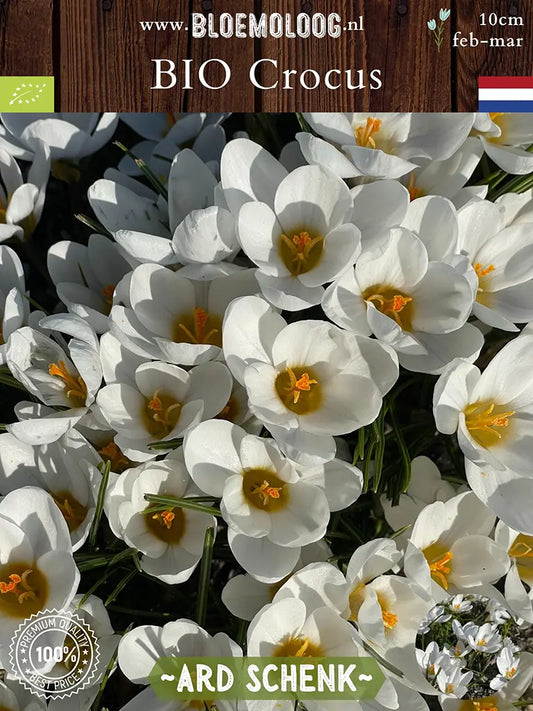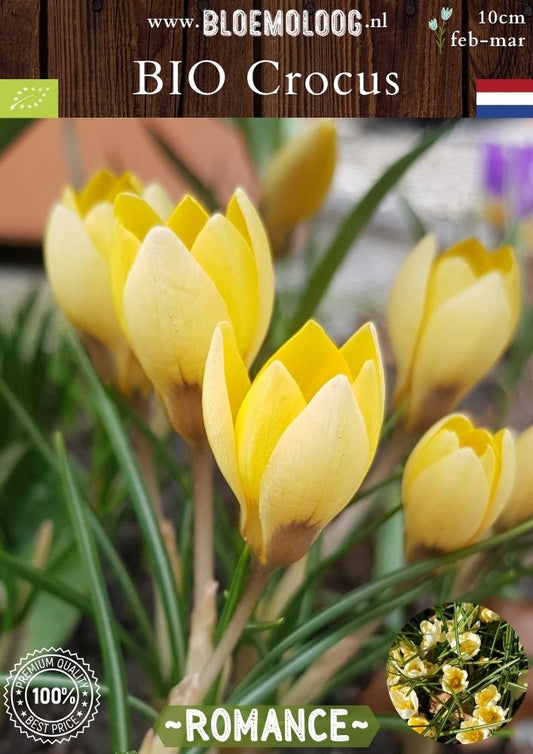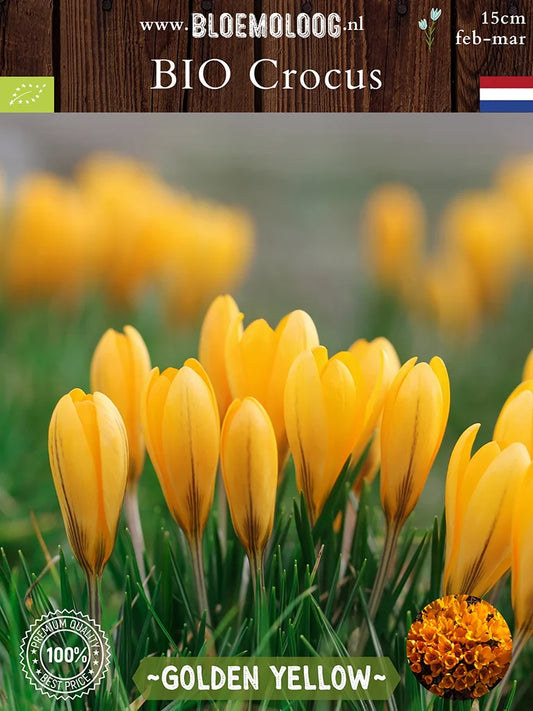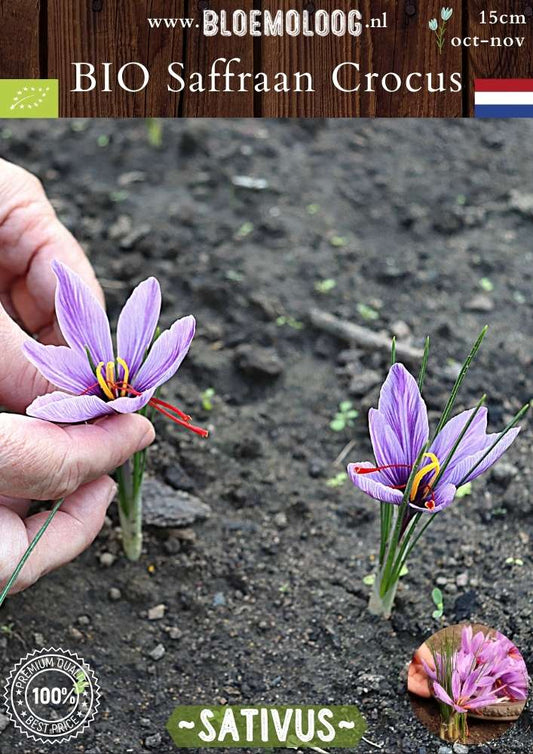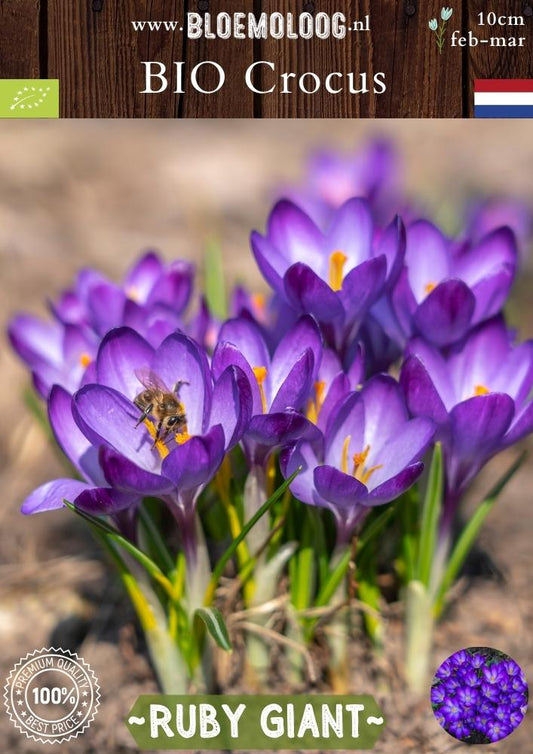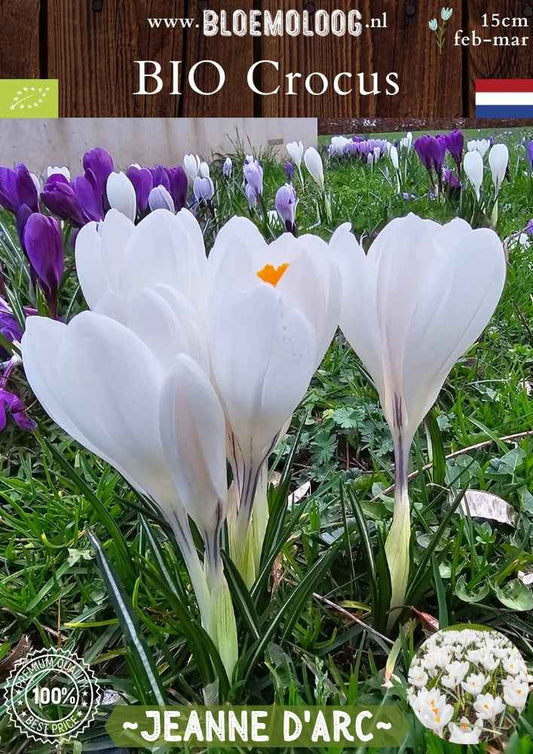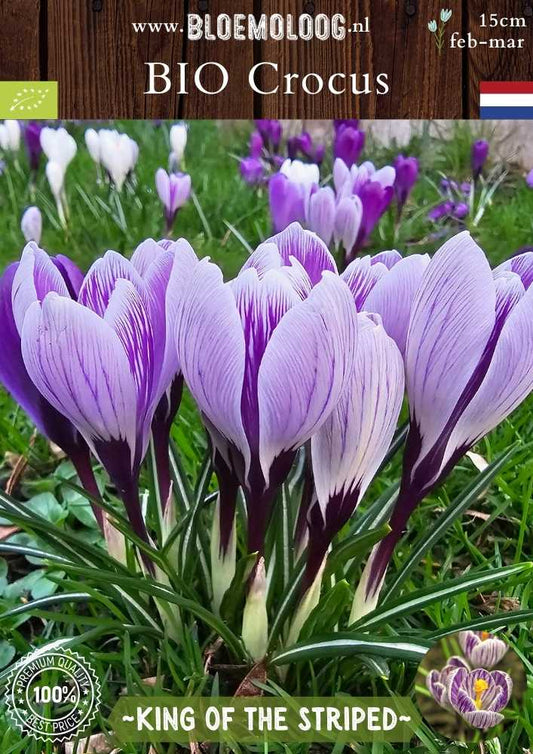
Collection: Organic Crocuses
Organically Grown Crocuses
Crocuses are part of the iris family and are often among the first flowers to appear in spring. They usually bloom before trees and shrubs have their leaves, making them stand out in the still-bare landscape. With their star-shaped flowers, they bring an instant splash of colour to the garden. Whether you plant them in borders, pots on your terrace, or even in the grass – crocuses will surprise you year after year.
Some species belong to the so-called "stinzenplants" – old garden plants that have naturalised over centuries in Dutch gardens and estates. Crocuses are not only beautiful but also reliable. They return faithfully each year and often multiply on their own, giving you enjoyment for many seasons to come.
Flower Bulbs for Bees
Crocuses are valuable early and late bloomers for bees and bumblebees. Their flowers contain both nectar and pollen, making them an important food source – especially in periods when little else is in bloom. By planting crocuses in your garden, you help pollinating insects get the energy they need to support other plants. In doing so, you contribute to healthy biodiversity.
Ideal Spot for Crocuses
A crocus thrives best in full sun or light shade. The soil should be well-drained to prevent excess moisture. Adding organic matter such as compost improves soil quality. They also bloom beautifully in pots or in grassy areas. There’s always a spot for a crocus!
Botanical Crocuses
There are several types of botanical crocuses, also known as 'wild crocuses', such as the Crocus tommasinianus, also called “boerenkrokus”. Wild crocuses are easy to care for, as they naturalise well. Each variety has its own unique charm, though their blooms are generally smaller than the large-flowered Dutch cultivars.
Large-Flowered Crocuses
We offer three types of large-flowered crocuses. In addition to the purple and white striped vernus 'King of the Striped', we also have the white vernus 'Jeanne d'Arc'. These are also known as striped or “bonte” crocuses. They bloom slightly later than the botanical varieties and their flowers can reach up to 10 cm wide in full sun. The yellow flavus 'Golden Yellow' blooms a bit earlier and is smaller than the striped crocuses but larger than most wild types.
Saffron Crocus
Although the saffron crocus blooms in autumn, it is often grouped with the spring bulbs because it is harvested at the same time.
Plant the bulbs in September to enjoy a stunning late bloom in October or November and fresh winter greenery. The Crocus sativus is a reliable bloomer that, with the right spot and care, will return year after year.
Buy Crocuses
From June to January, you can order organic crocus bulbs from Bloemoloog.nl. They are delivered from September onwards, during planting season. From August to January, you can also handpick your bulbs at our market stall. Visit us at one of our markets.
-
Organic Crocus chrysanthus 'Ard Schenk' | 10 pcs.
Regular price €3,95Regular priceUnit price €0,40 each -
Organic Crocus chrysanthus 'Romance' (botanical) | 10 pcs.
Regular price €3,95Regular priceUnit price €0,40 each -
Organic Crocus flavus 'Golden Yellow' | 10 Pcs.
Regular price €3,95Regular priceUnit price €0,40 each -
Organic Crocus sativus XL - Saffron Crocus | 7 pcs.
Regular price €5,95Regular priceUnit price €0,85 each -
Organic Crocus tommasinianus 'Ruby Giant' - Tommy Crocus | 10 pcs.
Regular price €3,95Regular priceUnit price €0,40 each -
Organic Crocus vernus 'Jeanne d'Arc' - Giant Dutch crocus | 10 pcs.
Regular price €3,95Regular priceUnit price €0,40 each -
Organic Crocus vernus 'King of the Striped' - Giant dutch crocus | 10 pcs.
Regular price €3,95Regular priceUnit price €0,40 each
-
Organic spring bulbs
Spring-flowering bulbs and tubers are popular plants that produce beautiful flowers from early spring through summer. Because of their early bloom, they combine well with perennials when they still need to establish themselves.
Tulips are probably the most well-known spring flowers. They come in many different colors, shapes, and sizes. Daffodils are known for their cheerful yellow flowers, but they also come in other colors like white and orange. Crocuses are small bulbous plants with striking flowers in shades of purple, yellow, and white. They are often the first flowers to appear in spring. Hyacinths have fragrant flowers in various colors, such as pink, purple, blue, and white. They are often planted in borders, flower beds, or pots.Benefits of organic spring bulbs
When you choose organic flower bulbs that bloom in spring, you can be sure that no chemicals or pesticides will end up in your garden. These pesticides are harmful to bees and prevent them from finding their nests. As a result, more and more bee species have been added to the red list in recent years. Together, we can do something about this!
Flower bulbs for wild bees
Did you know that wild bees lay eggs in their nests, which then hatch in early spring? These newborn insect helpers immediately search for food in the surrounding area. There are also insects that have hibernated and are desperately looking for a hearty breakfast: the blooming flowers where nectar and pollen can be found! Just after winter, there's little greenery or food for these insects. Planting early-blooming flower bulbs ensures there's food available, and the insects can gain strength for the coming summer.
Organic growers
The organic growers we work with cultivate not only the most beautiful but also the strongest products. They cultivate varieties and species of flowers and plants that experience has shown to be virus-resistant, so they don't need to use chemicals and pesticides. Organic growers seek natural remedies and solutions against diseases and/or pests. All our flower bulbs are certified organic; both the Florist and the growers are SKAL-certified.
When do you plant spring bulbs?
Spring-flowering bulbs can be planted from autumn until January. Bulbs that need to be dug up in the summer after flowering should be dug up starting in late July and stored until the next planting season in autumn.
What to do after flowering
When spring bloomers have finished blooming, cut off the wilted flowers at the top of the stem. Let the rest of the plant die back naturally so it can still receive maximum energy from the sun.
How do you store spring bulbs?
If you've purchased flower bulbs from us and had them delivered to your home and would like to leave them for a while, we recommend opening the box and storing it in a ventilated, cool place until you're ready to plant them.
Store flower bulbs you dig up after flowering in a warm place, such as a shed. To prevent mice from eating the bulbs during this period, you can also hang them in a bag or pantyhose. -
Where is the best place to plant spring bulbs?
Spring-flowering bulbs are flowers that bloom in the spring, between January and July. There are many different types of spring-flowering bulbs, suitable for different types of gardens and soil. For example, some bulb plants enjoy catching a glimpse of the sun during flowering, but prefer to be covered by a tree during their dormant period in summer.
Spring bloomers in the sun
Many spring bloomers need plenty of sun to bloom and grow well for the following year. These flowers thrive in full sun:
Spring bloomers in the shade
Some spring bloomers also grow and bloom well in the shade, such as:
Spring bloomers in moist soil types
There are also flower bulbs that can be planted in moist soil. Some varieties from the Florist's collection include:
Conclusion
There are many different types of spring bloomers suitable for different types of gardens and soil. Whether a spring bloomer can grow in sun or shade depends on the specific variety. Some prefer dry soil, while others prefer wet feet. So, there's a suitable spring bloomer for every garden.
Tips for a flowery garden
Plant a variety of flowers, each with its own blooming time, so there are flowers blooming throughout the spring and food for bees and other insects in your garden. Would you also like to arrange your garden/bed so you can enjoy flowers all spring long, and the bees too? Feel free to send us a message or ask us at the market stall. We're happy to help! Promote biodiversity in your garden and enjoy the first flowers and colors after the cold and dark winter!
Order spring bloomers in advance
Pre-sales for spring-flowering bulbs will begin on June 1st in the Bloemoloog webshop.
During the pre-sale, you can pre-order your desired products. This way, you can be sure your favorite flowers are still in stock, and we'll ship your package with PostNL as soon as planting time arrives.
Flower bulbs ordered in the pre-sale will be delivered in mid-September. From then on, they can be planted directly in the garden or in containers on the balcony.


